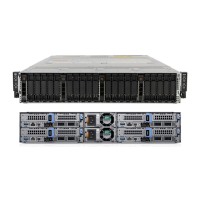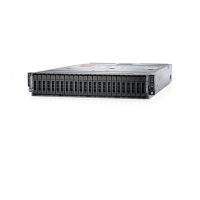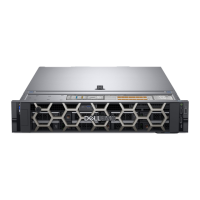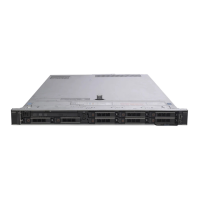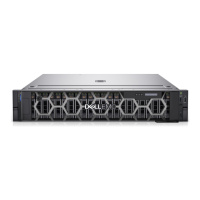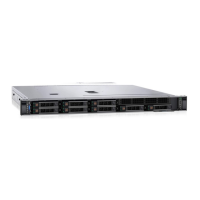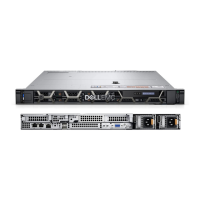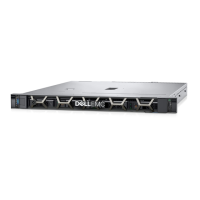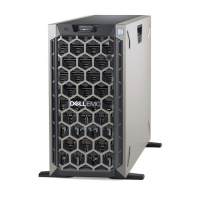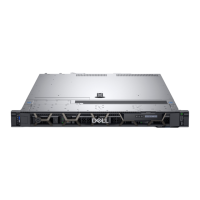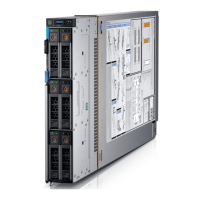Do you have a question about the Dell EMC PowerEdge C6420 and is the answer not in the manual?
Details the supported configurations for the PowerEdge C6420 system.
Illustrates and describes the back panel features and connectors of the PowerEdge C6420 sled.
Explains the indicator codes for LAN ports on QSFP carrier and mezzanine cards.
Provides a mapping of sleds to hard drive locations for different drive configurations.
Guides users on how to find the system's Service Tag and Express Service Code.
Provides links to documentation for installing and setting up the system.
Details documentation for iDRAC features, configuration, and remote management.
Lists resources for Dell's systems management software like OpenManage and SupportAssist.
Specifies the physical dimensions of the PowerEdge C6420 sled.
Details the weight specifications for the PowerEdge C6400 enclosure with C6420 sleds.
Outlines the supported processor types and core counts for the PowerEdge C6420 sled.
Describes the type of system battery used in the PowerEdge C6420 sled.
Lists the supported PCIe slot types and their form factors.
Details the supported memory types, speeds, and capacities for the sled.
Specifies supported drive options, capacities, and RAID configurations.
Lists supported video resolutions, refresh rates, and color depths.
Covers temperature, humidity, vibration, shock, and altitude specifications.
Explains how temperature limits are adjusted based on altitude.
Defines acceptable levels for air filtration and contamination.
Provides standard operating temperature ranges for various system configurations.
Details expanded temperature ranges and their operational constraints.
Lists restrictions and requirements for operating the system with fresh air cooling.
Step-by-step guide for unpacking, installing, and connecting the system.
Explains the role and benefits of the Integrated Dell Remote Access Controller (iDRAC).
Details methods for configuring the iDRAC IP address using various interfaces.
Provides instructions on how to log in to the iDRAC interface.
Lists resources and methods for installing the operating system.
Explains various methods for downloading system firmware and drivers.
Provides steps to download and install the latest BIOS, drivers, and firmware.
Lists available options for managing system settings before OS boot.
Guide to configuring BIOS, iDRAC, and device settings via the System Setup utility.
Steps to access and view the System Setup screen.
Details the options available within the System Setup Main Menu.
Explains how to use the System BIOS screen for configuration.
Procedure to access and view the System BIOS settings.
Provides detailed explanations of System BIOS settings options.
Explains how to view system properties like Service Tag and BIOS version.
Steps to access and view system information.
Details the various system information fields available.
Details how to view and configure memory settings.
Procedure to access and view memory settings.
Provides descriptions for each memory setting option.
Explains how to view and configure processor settings.
Procedure to access and view processor settings.
Details various processor settings like logical processors and virtualization.
Details how to view and configure SATA settings.
Procedure to access and view SATA settings.
Provides descriptions for SATA port settings and drive configurations.
Details how to set NVMe drives to RAID or Non-RAID mode.
Procedure to access and view NVMe settings.
Provides descriptions for NVMe mode settings.
Details how to set boot mode and boot order.
Procedure to access and view boot settings.
Provides descriptions for boot mode, sequence, and option settings.
Explains the available system boot modes (BIOS and UEFI).
Instructions on how to modify the system's boot order.
Details how to view and configure integrated device parameters.
Procedure to access and view integrated device settings.
Describes various integrated device settings like USB ports and embedded NIC.
Explains how to enable or disable PCIe slots on the system.
Details the options for PCIe slot bifurcation.
Details how to view and configure serial communication port settings.
Procedure to access and view serial communication settings.
Provides descriptions for serial port address and baud rate settings.
Details how to configure system performance profiles.
Procedure to access and view system profile settings.
Describes various system profile settings like CPU power and memory frequency.
Details how to configure system security settings like passwords.
Procedure to access and view system security settings.
Provides detailed descriptions of system security options like TPM and secure boot.
Instructions for creating system and setup passwords.
Explains how to use the system password for security.
Instructions for deleting or changing existing system and setup passwords.
Describes system behavior when the setup password is enabled.
Details how to configure redundant OS information.
Procedure to access and view redundant OS control settings.
Describes options for redundant OS location and boot.
Details how to set system time, date, and asset tag.
Procedure to access and view miscellaneous settings.
Provides descriptions for miscellaneous settings like keyboard NumLock.
Explains the iDRAC settings utility for configuring iDRAC parameters.
Details how to configure device parameters.
Introduces the Dell Lifecycle Controller for system management.
Describes the capabilities of the Dell Lifecycle Controller.
Details how to select boot options and diagnostic utilities.
Procedure to access and view the Boot Manager.
Describes the options available in the Boot Manager main menu.
Explains how to select a one-time boot device.
Lists the utilities available within System Utilities.
Explains the PXE boot option for configuring networked systems remotely.
Provides critical safety warnings and precautions for component handling.
Prerequisites and steps to take before performing internal system maintenance.
Prerequisites and steps to take after performing internal system maintenance.
Lists the tools required for component removal and installation.
Shows an illustration of the C6400 enclosure interior with labeled components.
Introduces the PowerEdge C6420 sled and its features.
Step-by-step instructions for safely removing a sled from the enclosure.
Step-by-step instructions for safely installing a sled into the enclosure.
Information regarding the PERC battery.
Procedure for removing the PERC battery.
Procedure for installing the PERC battery.
Information about the air shroud's function in directing airflow.
Procedure for removing the air shroud.
Procedure for installing the air shroud.
Information about system memory types and capacities.
Recommended guidelines for installing memory modules to prevent issues.
Specific guidelines for different memory modes and DIMM types.
Procedure for removing a memory module (DIMM or NVDIMM-N).
Procedure for installing a memory module (DIMM or NVDIMM-N).
Information regarding the support bracket.
Procedure for removing the support bracket.
Procedure for installing the support bracket.
Information about the linking board and SATA cable connections.
Procedure for removing the linking board and SATA cable.
Procedure for installing the linking board and SATA cable.
Information about the processor and heat sink module (PHM).
Procedure for removing a processor and its heat sink module.
Procedure for installing a processor and its heat sink module.
Procedure for removing a fabric processor from its heat sink module.
Procedure for installing a fabric processor into its heat sink module.
Procedure for removing a non-fabric processor from its heat sink module.
Procedure for installing a non-fabric processor into its heat sink module.
Procedure for removing fabric and sideband cables.
Procedure for installing fabric and sideband cables.
Information about expansion cards and their function.
Details supported expansion options and their slot priorities.
Procedure for removing the expansion card riser assembly.
Procedure for installing the expansion card riser assembly.
Procedure for removing an expansion card.
Procedure for installing an expansion card.
Procedure for removing the riser card from the expansion card bracket.
Procedure for installing the riser card into the expansion card bracket.
Procedure for removing the M.2 SATA x16 riser.
Procedure for installing the M.2 SATA x16 riser.
Procedure for removing the M.2 SATA card.
Procedure for installing the M.2 SATA card.
Information about mezzanine and OCP cards.
Procedure for removing a mezzanine card.
Procedure for installing a mezzanine card.
Procedure for removing the mezzanine card bridge board.
Procedure for installing the mezzanine card bridge board.
Procedure for removing an Open Compute Project (OCP) card.
Procedure for installing an Open Compute Project (OCP) card.
Information about the Trusted Platform Module (TPM).
Procedure for replacing the Trusted Platform Module.
Steps to initialize the TPM for BitLocker users.
Steps to initialize the TPM 1.2 for TXT users.
Steps to initialize the TPM 2.0 for TXT users.
Information about the system battery and its function.
Procedure for replacing the system battery.
Procedure for installing the system battery.
Information about the system board (motherboard).
Procedure for removing the system board.
Procedure for installing the system board.
Introduction to Dell Embedded System Diagnostics (ePSA).
Steps to run diagnostics if the system does not boot.
Steps to run diagnostics using the Dell Lifecycle Controller.
Describes the controls for system diagnostics: configuration, results, health, and logs.
Details the jumper settings for BIOS configuration and password features.
Illustrates and describes system board connectors for component installation.
Procedure to disable and reset system and setup passwords using a jumper.
Explains the benefits of Dell SupportAssist for automated technical support.
Provides information on how to contact Dell for support and service options.
Instructions on how to provide feedback on Dell documentation.
Guide on using Quick Resource Locator (QRL) for system information access.
Details the supported configurations for the PowerEdge C6420 system.
Illustrates and describes the back panel features and connectors of the PowerEdge C6420 sled.
Explains the indicator codes for LAN ports on QSFP carrier and mezzanine cards.
Provides a mapping of sleds to hard drive locations for different drive configurations.
Guides users on how to find the system's Service Tag and Express Service Code.
Provides links to documentation for installing and setting up the system.
Details documentation for iDRAC features, configuration, and remote management.
Lists resources for Dell's systems management software like OpenManage and SupportAssist.
Specifies the physical dimensions of the PowerEdge C6420 sled.
Details the weight specifications for the PowerEdge C6400 enclosure with C6420 sleds.
Outlines the supported processor types and core counts for the PowerEdge C6420 sled.
Describes the type of system battery used in the PowerEdge C6420 sled.
Lists the supported PCIe slot types and their form factors.
Details the supported memory types, speeds, and capacities for the sled.
Specifies supported drive options, capacities, and RAID configurations.
Lists supported video resolutions, refresh rates, and color depths.
Covers temperature, humidity, vibration, shock, and altitude specifications.
Explains how temperature limits are adjusted based on altitude.
Defines acceptable levels for air filtration and contamination.
Provides standard operating temperature ranges for various system configurations.
Details expanded temperature ranges and their operational constraints.
Lists restrictions and requirements for operating the system with fresh air cooling.
Step-by-step guide for unpacking, installing, and connecting the system.
Explains the role and benefits of the Integrated Dell Remote Access Controller (iDRAC).
Details methods for configuring the iDRAC IP address using various interfaces.
Provides instructions on how to log in to the iDRAC interface.
Lists resources and methods for installing the operating system.
Explains various methods for downloading system firmware and drivers.
Provides steps to download and install the latest BIOS, drivers, and firmware.
Lists available options for managing system settings before OS boot.
Guide to configuring BIOS, iDRAC, and device settings via the System Setup utility.
Steps to access and view the System Setup screen.
Details the options available within the System Setup Main Menu.
Explains how to use the System BIOS screen for configuration.
Procedure to access and view the System BIOS settings.
Provides detailed explanations of System BIOS settings options.
Explains how to view system properties like Service Tag and BIOS version.
Steps to access and view system information.
Details the various system information fields available.
Details how to view and configure memory settings.
Procedure to access and view memory settings.
Provides descriptions for each memory setting option.
Explains how to view and configure processor settings.
Procedure to access and view processor settings.
Details various processor settings like logical processors and virtualization.
Details how to view and configure SATA settings.
Procedure to access and view SATA settings.
Provides descriptions for SATA port settings and drive configurations.
Details how to set NVMe drives to RAID or Non-RAID mode.
Procedure to access and view NVMe settings.
Provides descriptions for NVMe mode settings.
Details how to set boot mode and boot order.
Procedure to access and view boot settings.
Provides descriptions for boot mode, sequence, and option settings.
Explains the available system boot modes (BIOS and UEFI).
Instructions on how to modify the system's boot order.
Details how to view and configure integrated device parameters.
Procedure to access and view integrated device settings.
Describes various integrated device settings like USB ports and embedded NIC.
Explains how to enable or disable PCIe slots on the system.
Details the options for PCIe slot bifurcation.
Details how to view and configure serial communication port settings.
Procedure to access and view serial communication settings.
Provides descriptions for serial port address and baud rate settings.
Details how to configure system performance profiles.
Procedure to access and view system profile settings.
Describes various system profile settings like CPU power and memory frequency.
Details how to configure system security settings like passwords.
Procedure to access and view system security settings.
Provides detailed descriptions of system security options like TPM and secure boot.
Instructions for creating system and setup passwords.
Explains how to use the system password for security.
Instructions for deleting or changing existing system and setup passwords.
Describes system behavior when the setup password is enabled.
Details how to configure redundant OS information.
Procedure to access and view redundant OS control settings.
Describes options for redundant OS location and boot.
Details how to set system time, date, and asset tag.
Procedure to access and view miscellaneous settings.
Provides descriptions for miscellaneous settings like keyboard NumLock.
Explains the iDRAC settings utility for configuring iDRAC parameters.
Details how to configure device parameters.
Introduces the Dell Lifecycle Controller for system management.
Describes the capabilities of the Dell Lifecycle Controller.
Details how to select boot options and diagnostic utilities.
Procedure to access and view the Boot Manager.
Describes the options available in the Boot Manager main menu.
Explains how to select a one-time boot device.
Lists the utilities available within System Utilities.
Explains the PXE boot option for configuring networked systems remotely.
Provides critical safety warnings and precautions for component handling.
Prerequisites and steps to take before performing internal system maintenance.
Prerequisites and steps to take after performing internal system maintenance.
Lists the tools required for component removal and installation.
Shows an illustration of the C6400 enclosure interior with labeled components.
Introduces the PowerEdge C6420 sled and its features.
Step-by-step instructions for safely removing a sled from the enclosure.
Step-by-step instructions for safely installing a sled into the enclosure.
Information regarding the PERC battery.
Procedure for removing the PERC battery.
Procedure for installing the PERC battery.
Information about the air shroud's function in directing airflow.
Procedure for removing the air shroud.
Procedure for installing the air shroud.
Information about system memory types and capacities.
Recommended guidelines for installing memory modules to prevent issues.
Specific guidelines for different memory modes and DIMM types.
Procedure for removing a memory module (DIMM or NVDIMM-N).
Procedure for installing a memory module (DIMM or NVDIMM-N).
Information regarding the support bracket.
Procedure for removing the support bracket.
Procedure for installing the support bracket.
Information about the linking board and SATA cable connections.
Procedure for removing the linking board and SATA cable.
Procedure for installing the linking board and SATA cable.
Information about the processor and heat sink module (PHM).
Procedure for removing a processor and its heat sink module.
Procedure for installing a processor and its heat sink module.
Procedure for removing a fabric processor from its heat sink module.
Procedure for installing a fabric processor into its heat sink module.
Procedure for removing a non-fabric processor from its heat sink module.
Procedure for installing a non-fabric processor into its heat sink module.
Procedure for removing fabric and sideband cables.
Procedure for installing fabric and sideband cables.
Information about expansion cards and their function.
Details supported expansion options and their slot priorities.
Procedure for removing the expansion card riser assembly.
Procedure for installing the expansion card riser assembly.
Procedure for removing an expansion card.
Procedure for installing an expansion card.
Procedure for removing the riser card from the expansion card bracket.
Procedure for installing the riser card into the expansion card bracket.
Procedure for removing the M.2 SATA x16 riser.
Procedure for installing the M.2 SATA x16 riser.
Procedure for removing the M.2 SATA card.
Procedure for installing the M.2 SATA card.
Information about mezzanine and OCP cards.
Procedure for removing a mezzanine card.
Procedure for installing a mezzanine card.
Procedure for removing the mezzanine card bridge board.
Procedure for installing the mezzanine card bridge board.
Procedure for removing an Open Compute Project (OCP) card.
Procedure for installing an Open Compute Project (OCP) card.
Information about the Trusted Platform Module (TPM).
Procedure for replacing the Trusted Platform Module.
Steps to initialize the TPM for BitLocker users.
Steps to initialize the TPM 1.2 for TXT users.
Steps to initialize the TPM 2.0 for TXT users.
Information about the system battery and its function.
Procedure for replacing the system battery.
Procedure for installing the system battery.
Information about the system board (motherboard).
Procedure for removing the system board.
Procedure for installing the system board.
Introduction to Dell Embedded System Diagnostics (ePSA).
Steps to run diagnostics if the system does not boot.
Steps to run diagnostics using the Dell Lifecycle Controller.
Describes the controls for system diagnostics: configuration, results, health, and logs.
Details the jumper settings for BIOS configuration and password features.
Illustrates and describes system board connectors for component installation.
Procedure to disable and reset system and setup passwords using a jumper.
Explains the benefits of Dell SupportAssist for automated technical support.
Provides information on how to contact Dell for support and service options.
Instructions on how to provide feedback on Dell documentation.
Guide on using Quick Resource Locator (QRL) for system information access.
| Processor | Intel Xeon Scalable processors |
|---|---|
| Management | iDRAC9 |
| Max Processors | 2 per node |
| Memory | DDR4 |
| Storage | Up to 6 x 2.5" drives |
| Drive Bays | 24 x 2.5" or 12 x 3.5" |
| Network | 2 x 10GbE ports per sled |
| Power Supply | Dual, 2000W |
| Operating System Support | Windows Server, Red Hat Enterprise Linux, SUSE Linux Enterprise Server, VMware ESXi |
| Maximum RAM | Up to 3TB per node |
| Max Memory | Up to 3TB per node |
